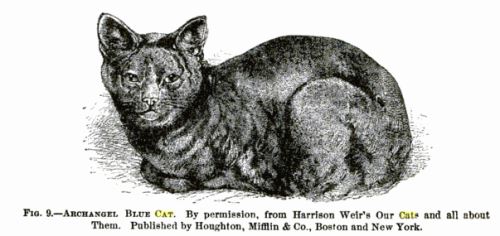
Russian Blue Cat Photo © copyright Helmi Flick
Introduction

Copyright free map see below
As is the case for many natural cat breeds the origin of this cat is hazy. On the basis that this is indeed a cat that has evolved naturally without mankind’s involvement until becoming a pedigree cat, the Russian Blue, as the name suggests, comes from Russia. More particularly, the town of Archangel in North Russia(see map underlined in red). The city (or is it a town) is now called Arckhangelsk.
If you want to see a bigger and better map plus bigger high quality Helmi Flick pictures of the Russian Blue cat in a slide show accompanying a description of this breed with reference to a breed standard then click on the link: Russian Blue.
Far from me to suggest it, but it does seem a very happy coincidence that a cat that comes from cold and icy Russia should naturally be cold and icy in appearance. Perhaps this cat breed’s appearance has been refined, by careful breeding. Amanda Bright who has been breeding Russian Blues for almost 39 years says, “the Russian Blue did originate in Arkhangelsk and was developed in England AND the USA beginning in the late 1800s and early 1890s. Early USA cats included Peterkin, Peterkin II and Fiametta — and we have pictures of these American Russian Blues. There was also a cat called Olivette who was a Bayard daughter.” Thank you Amanda.

Photo: © copyright Helmi Flick
Update 28-7-09: I have had a welcome message from a mysterious contributor who has the following to say about this breed – to add to what I have written. I judge it to be accurate and quote it verbatim for accuracy. Thanks for the input by the way!:
First RB (Russian Blue) shown in the crystal palace had domestic parents, see “Our Cats” by Harrison Weir, who organized the show, where he describes the parents of this first “Russian blue” as being VERY non-blue..LOL
Blue cats of many kinds were imported into England from supposedly “Russia”, i.e. blue and white, solid blue, blue tabby…it was the humans who decided to work only with the solid blue…there are no natural barriers in the area of Archangelisk to keep shorthaired blue only cats separate from any other hair length or color.
So, what I am saying is they are not a “natural” breed, just a common blue color that the breeders decided to make into a breed. ACFA, TICA and GCCF DO recognize the whites/blacks/tabbies for showing in provisional classes, just not for championship yet.
The “colors” are accepted by, as you mentioned Australian and New Zealand registries, plus LOOF in France, South African cat registry and many smaller independent cat registries all over Europe–i.e. Neocat etc (Europe has a different system and it is hard to find out exactly which independent registries accept what breed and colors).
You are correct that CFA only recognizes the Russian in the color blue. Also, those first two Russian Blues registered in the 1940’s in the CFA studbooks actually have a British Blue for a dam! There is also a question about some of the earlier “Russian blues” pedigrees, i.e. coming from Brits or alley cats, imported into the USA in the early 1900’s.

An engraving from Popular Science 1890



I have just read your first comment and see that she was rescued. Do we know the original owner and how he/she acquired her? That would help. I have responded to your other comment for which I thank you.